
Liquid hydrogen (H2(l)) is the liquid state of the element hydrogen. Hydrogen is found naturally in the molecular H2 form.

A jerrycan or jerrican is a robust liquid container made from pressed steel. It was designed in Germany in the 1930s for military use to hold 20 litres of fuel, and saw widespread use by both Germany and the Allies during the Second World War.

A boiling liquid expanding vapor explosion is an explosion caused by the rupture of a vessel containing a pressurized liquid that has reached a temperature above its boiling point. Because the boiling point of a liquid rises with pressure, the contents of the pressurized vessel can remain a liquid as long as the vessel is intact. If the vessel's integrity is compromised, the loss of pressure drops the boiling point, which can cause the liquid to convert to a gas expanding rapidly. If the gas is combustible, as in the case with hydrocarbons and alcohols, further damage can be caused by the ensuing fire.
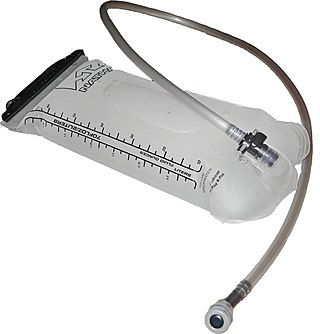
A hydration system is an apparatus used in recreation and other sustained outdoor activities. It is intended to help its user carry liquid, to support the physical effort involved in the activity, without the need to use one's hands or take off the pack. Such systems for consumers were first sold to cyclists, and by the 1990s had also found a substantial market among hikers. Familiar commercial models can also be recognized occasionally worn by western military personnel in southwest Asia.

A fuel tank is a safe container for flammable fluids, often gasoline or diesel fuel. Though any storage tank for fuel may be so called, the term is typically applied to part of an engine system in which the fuel is stored and propelled or released into an engine. Fuel tanks range in size and complexity from the small plastic tank of a butane lighter to the multi-chambered cryogenic Space Shuttle external tank.

A gas cylinder is a pressure vessel for storage and containment of gases at above atmospheric pressure. High-pressure gas cylinders are also called bottles. Inside the cylinder the stored contents may be in a state of compressed gas, vapor over liquid, supercritical fluid, or dissolved in a substrate material, depending on the physical characteristics of the contents. A typical gas cylinder design is elongated, standing upright on a flattened bottom end, with the valve and fitting at the top for connecting to the receiving apparatus.

An underground storage tank (UST) is, according to United States federal regulations, a storage tank, including any underground piping connected to the tank, that has at least 10 percent of its volume underground.
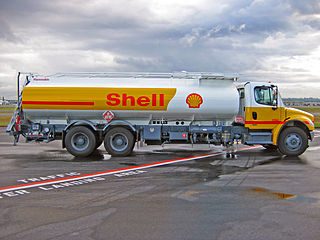
A tank truck, gas truck, fuel truck, or tanker truck or tanker is a motor vehicle designed to carry liquids or gases on roads. The largest such vehicles are similar to railroad tank cars, which are also designed to carry liquid loads. Many variants exist due to the wide variety of liquids that can be transported. Tank trucks tend to be large; they may be insulated or non-insulated; pressurized or non-pressurized; and designed for single or multiple loads. Some are semi-trailer trucks. They are difficult to drive and highly susceptible to rollover due to their high center of gravity, and potentially the free surface effect of liquids sloshing in a partially filled tank.

Intermediate bulk containers are industrial-grade containers engineered for the mass handling, transport, and storage of liquids, semi-solids, pastes, or solids. The two main categories of IBC tanks are flexible IBCs and rigid IBCs. Many IBCs are reused or repurposed.
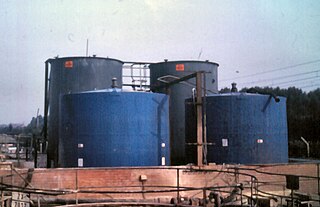
Bunding, also called a bund wall, is a constructed retaining wall around storage "where potentially polluting substances are handled, processed or stored, for the purposes of containing any unintended escape of material from that area until such time as a remedial action can be taken."

A water tank is a container for storing water. They are used to provide storage of water for use in many applications, drinking water, irrigation agriculture, fire suppression, agricultural farming, both for plants and livestock, chemical manufacturing, food preparation as well as many other uses. Water tank parameters include the general design of the tank, and choice of construction materials, linings. Various materials are used for making a water tank: plastics, fiberglass, concrete, stone, steel. Earthen pots, such as matki used in South Asia, can also be used for water storage. Water tanks are an efficient way to help developing countries to store clean water.
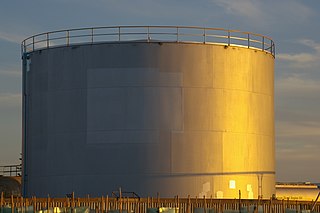
Storage tanks are containers that hold liquids, compressed gases or mediums used for the short- or long-term storage of heat or cold. The term can be used for reservoirs, and for manufactured containers. The usage of the word tank for reservoirs is uncommon in American English but is moderately common in British English. In other countries, the term tends to refer only to artificial containers.

Marble Point is a rocky promontory on the coast of Victoria Land, Antarctica. The United States operates a station at the point. The outpost is used as a helicopter refueling station supporting scientific research in the nearby continental interior, such as the McMurdo Dry Valleys. Dependent upon the weather conditions at the time, helicopters are able to fly in and out of the station 24 hours a day during the summer research season.

Collapsible tanks are used for storage of fuel, water, or chemicals and are manufactured using industrial fabrics.
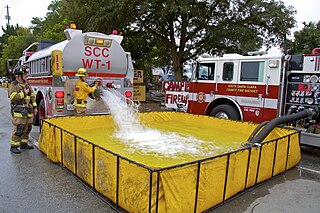
A portable water tank is a temporary collapsible tank designed for the reserve storage of water in firefighting, emergency relief, and military applications. These tanks can be either supported or unsupported. The supported tanks have a steel or aluminum frame and range in size from600 to 5,000 US gallons or larger by custom design. Portable water tanks are also unsupported such as self-supporting tanks, blivets and pillow or bladder tanks and are available in sizes ranging from 100 US gallons up to 80,000 US gallons.
A shipping container is a container with strength suitable to withstand shipment, storage, and handling. Shipping containers range from large reusable steel boxes used for intermodal shipments to the ubiquitous corrugated boxes. In the context of international shipping trade, "container" or "shipping container" is virtually synonymous with "intermodal freight container", a container designed to be moved from one mode of transport to another without unloading and reloading.
A pneumatic bladder is an inflatable (pneumatic) bag technology with many applications.

Flexible tanks are a kind of storage equipment for liquids such as water or oil. Compared to steel tanks, flexible tanks have many advantages, including lighter weight and being rustproof, foldable, and quicker and easier to set up. With the same capacity, an empty flexible tank may have just 10% of a steel tank's weight. The disadvantages of flexible tanks include lower durability and shorter longevity. Some flexible tanks can be used as transport containers on trucks, ships, or aeroplanes, with some suitable for use in airdrops, helicopter swing, or hauling water.

A bladder tank is a large, flexible container used to store many types of liquids. When maximum capacity is reached, the bladder tank takes the form of a large pillow, hence it is also called a pillow tank.

A fuel container is a container such as a steel can, bottle, drum, etc. for transporting, storing, and dispensing various fuels.



















